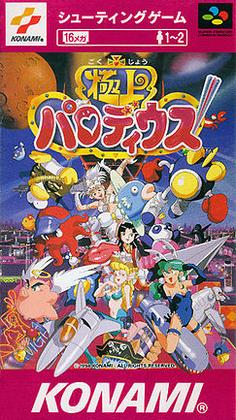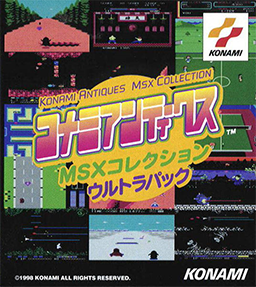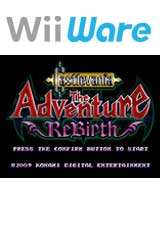Ultra Software Corporation was a shell corporation and publishing label created in 1988 as a subsidiary of Konami of America, in an effort to get around Nintendo of America's strict licensing rules in place at the time for the North American market. One of these rules was that a third-party company could only publish up to five games per year for the Nintendo Entertainment System in the US. This was hardly convenient for Konami, which had begun releasing more than ten games a year for both the Famicom and its Disk System add-on in Japan. With a greater library than it was allowed to localize, Konami formed the Ultra Games brand to extend its annual library to ten games a year.
TwinBee (ツインビー) is a video game series composed primarily of cartoon-themed vertical-scrolling shoot-'em-up games produced by Konami that were released primarily in Japan. The series originated as a coin-operated video game simply titled TwinBee in 1985, which was followed by several home versions and sequels. The character designs of almost every game in the series since Detana!! TwinBee in 1991 were provided by Japanese animator Shuzilow HA, who also planned and supervised most of the subsequent installments in the TwinBee series. The series also inspired a radio drama adaptation that lasted three seasons in Japan, as well as an anime adaptation.

Multi-memory controllers or memory management controllers (MMC) are different kinds of special chips designed by various video game developers for use in Nintendo Entertainment System (NES) cartridges. These chips extend the capabilities of the original console and make it possible to create NES games with features the original console cannot offer alone. The basic NES hardware supports only 40KB of ROM total, up to 32KB PRG and 8KB CHR, thus only a single tile and sprite table are possible. This limit was rapidly reached within the Famicom's first two years on the market and game developers began requesting a way to expand the console's capabilities.

Castlevania: The Adventure is a platform game released for the Game Boy in 1989. It is the first Castlevania title for the system. Castlevania: The Adventure was re-released in color as part of the Konami GB Collection compilations in Japan and Europe. A remake titled Castlevania: The Adventure ReBirth was released as a WiiWare game for the Wii. The original game is included in the Castlevania Anniversary Collection, which was released in 2019.

Castlevania II: Belmont's Revenge is a platform game released for the Game Boy in 1991. It is the second Castlevania title for the Game Boy and serves as a sequel to the previous title, Castlevania: The Adventure. Belmont's Revenge is included in color in the fourth volume of the Konami GB Collection compilations. Set fifteen years after the events of Castlevania: The Adventure, Dracula returns and kidnaps Christopher Belmont's son Soleil at his coming of age feast, and turns him into a demon. With Soleil's mystical powers, Dracula retakes human form and rebuilds his castle, forcing Christopher to confront Dracula once again to save his son and Transylvania.

Konami Krazy Racers is a kart racing video game published and developed by Konami for the Game Boy Advance handheld video game console. It was first released in Japan, and was later released in North America and some PAL regions. It was also re-released for Wii U Virtual Console on October 15, 2015 in Europe. It was a launch game for the system. Konami Krazy Racers makes use of a variety of characters and concepts from several of Konami's franchises, including Castlevania, Metal Gear, and Gradius. It plays similarly to the Mario Kart series, with eight characters per circuit and offensive/defensive items placed at predetermined points in the tracks.

Jikkyō Oshaberi Parodius is the fourth game in the Parodius franchise, a series of parody shooters produced by Konami. The gameplay is stylistically very similar to the Gradius series, but the graphics and music are intentionally absurd. The game contains a large number of Japanese voice samples shouted out in a style similar to that of a game show host. Unlike the previous two titles, Jikkyō Oshaberi Parodius was not created as an arcade game. It was first released on the Super Famicom in 1995 and then ported and updated for the PlayStation and Sega Saturn in 1996.
Gradius is a series of shooter video games, introduced in 1985, developed and published by Konami for a variety of portable, console and arcade platforms. In many games in the series, the player controls a ship known as the Vic Viper.

Parodius! From Myth to Laughter, released in Japan as Parodius Da! Shinwa kara Owarai e and outside Japan as Parodius, is a shoot 'em up arcade video game and the second title in the Parodius series produced by Konami. The European SNES, Sega Saturn and PlayStation versions are also known as Parodius: Non-Sense Fantasy. The gameplay is stylistically very similar to the Gradius series, but the graphics and music are intentionally absurd.

Parodius: The Octopus Saves the Earth, also known as Parodius, is a scrolling shooter video game developed by Konami for the MSX computer and was released in Japan. The game is notable for being the first title in the Parodius series, although it is often confused with its sequel Parodius! From Myth to Laughter. The name itself is a portmanteau of "Gradius" and "Parody" and, eponymously, the game is a parody of the Gradius series of space-based horizontally scrolling shooters. Many of the characters and enemies are derived from that famous shooter series, while other elements are extracted from other Konami titles, such as Antarctic Adventure and TwinBee. This game is of particular note in the series as being heavily infused with Japanese culture and folklore.

Gokujō Parodius ~Kako no Eikō o Motomete~, translated as Gokujo Parodius – Pursuing the Past Glory and also known as Fantastic Journey, is a 1994 side-scrolling shooter arcade game developed and published by Konami. It is the third entry in their Parodius series, itself a parody spin-off of their Gradius series.

Konami Wai Wai World, "wai wai" being a Japanese onomatopoeia for a noisy, crowded area, is a 1988 Family Computer platform video game released only in Japan by Konami. The game itself stars various Konami-created characters as well as Mikey and King Kong, who appeared in two Konami-produced, film-based games.

Wai Wai World 2: SOS!! Parsley Jō is a 1991 Famicom platform game released only in Japan by Konami. It is a sequel to Konami Wai Wai World, and stars various Konami characters. It was also re-released for the Wii U Virtual Console on September 2, 2015 in Japan.

Konami Antiques MSX Collection is a series of compilations of MSX computer games released by Konami in Japan. The compilation was split between three volumes for the PlayStation between 1997 and 1998, each containing ten games. All thirty games were later compiled onto a single disc for the Konami Antiques MSX Collection Ultra Pack on the Sega Saturn in 1998.

Ganbare Goemon: Sarawareta Ebisumaru! is a Game Boy game released in 1991 and the first game in the Ganbare Goemon series ever released for a portable system. Gameplay is similar to Ganbare Goemon! Karakuri Dōchū which was released on the Famicom. Only Goemon is playable, and the game consists of him rescuing Ebisumaru; Sasuke and Yae do not make appearances.
Shigeharu Umezaki is a Japanese video game producer. He worked previously as a programmer and producer for Konami and was also CEO of the now-defunct Konami Computer Entertainment Kobe branch. His works include the Nintendo Entertainment System versions of Contra and Life Force, the Legend of the Mystical Ninja series, Rakugakids, and some games in the Castlevania series. He currently leads Good Feel Co., Ltd., which is a Japanese video game developer that developed Wario Land: Shake It!, a game that was released for the Wii in 2008.

Castlevania: The Adventure ReBirth is a side-scrolling action platform game developed by M2, and released by Konami for the Wii in 2009 as a WiiWare title. It is a remake of the 1989 Game Boy title Castlevania: The Adventure and is the third game in M2's ReBirth series, following Gradius ReBirth and Contra ReBirth. The setting of the game is a century before the original Castlevania title, where the player controls an ancestor of Simon Belmont named Christopher Belmont, who must defeat the vampire Dracula.

Konami Wai Wai Sokoban (コナミワイワイ倉庫番) is a game of wits, Sokoban style mobile phone game which was published by Konami only in Japan in the i-mode platform and Yahoo! Keitai. It is the fourth game in the Konami Wai Wai series, and as it is traditional, it brings together popular characters from other Konami games.













